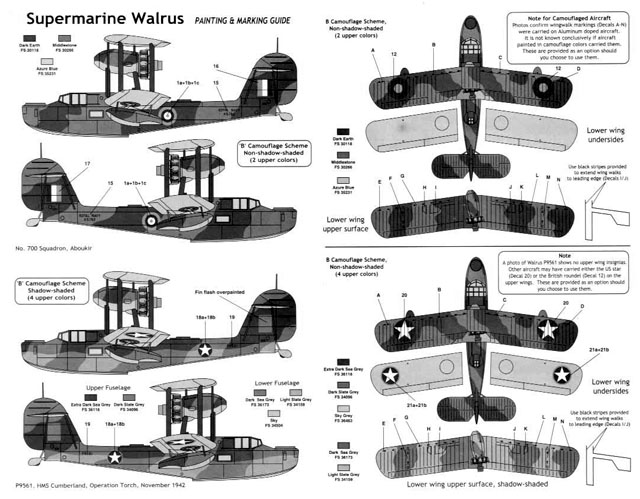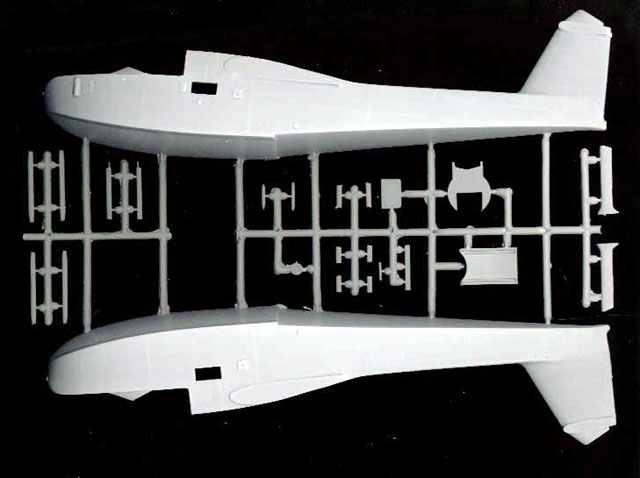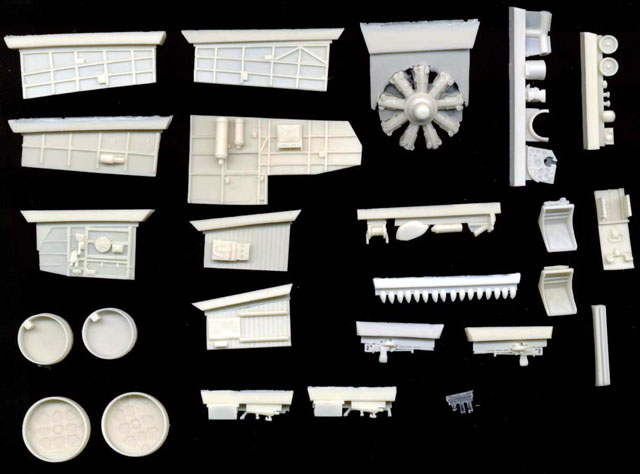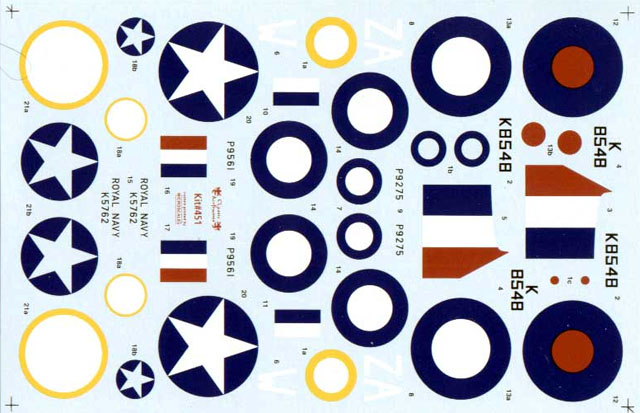|
Supermarine Walrus

Classic Airframes

Classic
Airframes' 1/48 scale Walrus is available online from Squadron.com
S
u m m a r y
|
| Catalogue Number
: |
451 |
| Scale: |
1/48 |
| Price: |
USD$44.95 RRP (USD $37.96 from
Squadron.com) |
| Contents and Media: |
Gray styrene; resin detail parts;
two vacform canopies; decal sheet with four marking options. |
| Review Type: |
FirstLook |
| Advantages: |
Smooth surface texture;
appropriately engraved detail; authentic fabric texture; detailed resin
cockpit; alternate parts for open or closed canopies; wide range of
marking options.. |
| Disadvantages: |
Resin pour plugs will need careful
removal; some reinforcement of upper wing and struts (and other elements)
recommended; vacform canopy & DIY fuselage windows; lots of alignment
challenges. |
| Recommendation: |
Highly Recommended for experienced
modellers. |
Reviewed by Lynn
Ritger
It may be justifiably argued by many Allied
airmen, plucked from the waters into which their stricken aircraft plunged, that
the Supermarine Walrus was by far the most beautiful aircraft ever seen.
Possessed of an ungainly but effective design and amazing utility, the Walrus
served from 1933 until well after the end of WWII performing tasks as varied as
rescue duty, artillery spotting, Arctic exploration, and I’m told whale spotting
was performed postwar as well!
Others can relate in detail the saga of this
previously overlooked but immensely valuable aircraft, but it is my intention to
share my impressions of the latest offering from Classic Airframes.
My first impression on opening the plain white
box (no printed boxes were available at the time the review sample was shipped)
was “WOW, that’s a big airplane!” I had not yet taken the time to
familiarize myself with the basics of the aircraft, and was quite surprised to
see just how large the ‘Shagbat’ really is in comparison to other period
aircraft.
On closer inspection, Classic Airframe’s new 1/48 scale Walrus shows that the
sophistication noted in their recent Reggiane fighter releases is carrying
forward into their future releases. Molded in medium grey styrene with their
now-traditional profusion of resin detail parts, the surfaces of the airframe
parts are extremely clean and free of any rough texture. Panel lines are of
course engraved, and lightly done at that. The fabric texture of the wings is
extremely well done and, in my opinion, accurately reflects the different
surface tensions present in the canvas covering of the different flying
surfaces. There are indentations at all major strut mounting points on the
flying surfaces, and based on previous experience I would strongly recommend
drilling these out as well as the corresponding mating surfaces of the struts
and adding small pieces of 24 or 28 gauge wire to the struts to provide a more
sturdy join. This is admittedly time consuming, but will pay off in strength and
flexibility on the model when complete.

An excellent suggestion made by a fellow club member (Chris Durden) is to add a
spar along the upper wing…there is a center section to which the outboard wing
panels are joined with 3 degrees dihedral, and installing a spar will help with
both the alignment as well as the strength of the structure when completed. I
also believe that the lower wing and tailplanes will benefit from such
strengthening measures. I intend to add several small pieces of 24 gauge wire
along the edges of the lower wing mating surface to provide more “bite” against
the mounting face on the fuselage. This approach worked well on the CA F4B-4 I
built, and the resultant model became strong enough to stand up to an
inadvertent drop onto a thinly covered concrete floor!
Click the
thumbnails below to view larger images:
A pair of vacuformed canopies is provided, one
featuring a flip-forward panel over the right side of the cockpit. No other
differences between the canopies are noted.
The aft hatch window is featured on the vac
sheet as well. The instructions call for the side windows to be cut from a .010
sheet of clear styrene, also provided. This should not prove to be beyond the
capabilities of most modelers. It may pay off to coat the sheet of plastic
beforehand with Future (or Johnson’s Klear or whatever it may be called in your
part of the world) as this barrier will resist fogging from superglue fumes…this
will allow you to affix the windows using superglue without fear of crazing or
fogging the window.
As with many of their other releases, the resin parts are extremely well done
and provide for a very thoroughly equipped interior. Among the nicer features
are a single-piece Bristol Pegasus engine and a pair of simply gorgeous machine
guns (Vickers ‘K’ guns as best I can tell…Lewis guns were an option on the
full-scale article). The row of small aerodynamic fairings for the flying wires
will certainly provide hours of fun.

One area to note for those looking forward to the kit: resin pour plugs are on
the back of the wheel wells, some interior bulkheads, and the two ring mounts
for the guns. These should not prove to be trouble given a bit of patience, a
razor saw, and sandpaper, and they are by no means as offensive as those on the
Blenheim kit!
The instructions are quite thorough, and offer a rigging diagram for all areas
requiring such treatment (e.g. the outboard floats, the engine assembly, and the
interplane rigging). Alignment peculiarities abound on the Walrus, and the
instruction sheet takes great pains in explaining these; chief among the
interesting alignment challenges is the 5 degree offset of the engine nacelle. A
full-scale 1/48 template is provided to assist in proper alignment of the
nacelle.
 Markings
for no less than four aircraft are provided in the kit, including two 700 Sqn
examples, an Australian aircraft, and an unusual Operation Torch aircraft
sporting overpainted British markings and yellow-ringed American insignia as
well as a “shadow shaded” upper surface camouflage scheme featuring four
different colors! Markings
for no less than four aircraft are provided in the kit, including two 700 Sqn
examples, an Australian aircraft, and an unusual Operation Torch aircraft
sporting overpainted British markings and yellow-ringed American insignia as
well as a “shadow shaded” upper surface camouflage scheme featuring four
different colors!
This last is intriguing enough to be my first
choice! Printed by Microscale, the samples in my kit are impressively thin and
in perfect register.

Overall, I have to say I am tremendously impressed with this latest effort. True
to Classic Airframes’ tradition, they have released a stunning rendition of an
often overlooked but important aircraft, and I am eagerly looking forward to
starting the kit!
One further note - I would like to point out that my friend Bryan Ribbans has a
great selection of Walrus walkaround photos (including interior photos of an
example undergoing restoration in Australia) on his terrific website at
http://www.seawings.co.uk . I shall be
visiting that site quite frequently during the construction of the “Shagbat”!
Thanks to Classic Airframes for the review
sample
Review Text and Images Copyright © 2001 by
Lynn Ritger
Page Created 17 December, 2001
Last updated 22 July, 2003
Back to HyperScale
Main Page
Back to Reviews
Page
|
Home | What's
New | Features
| Gallery |
Reviews | Reference
| Forum
| Search